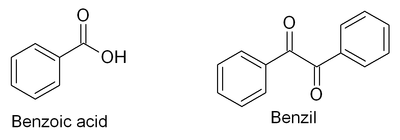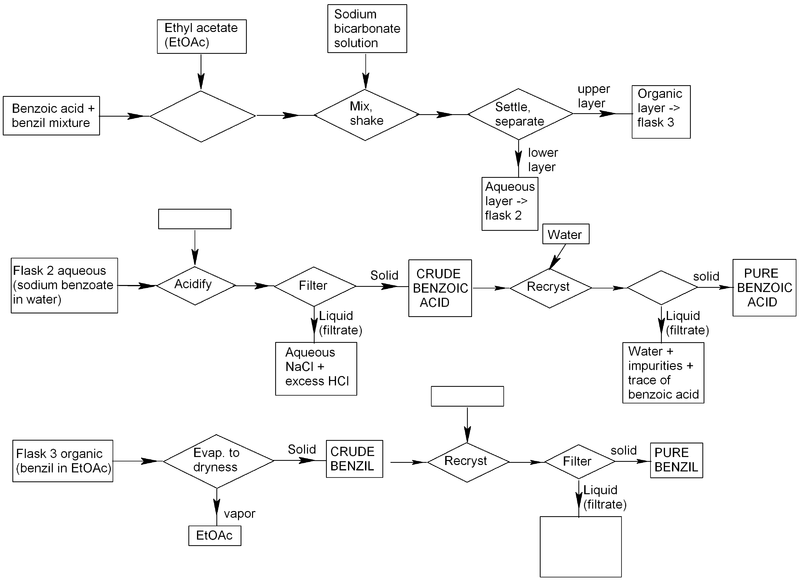Expt:Separation of an Acid from a Neutral by Base Extraction
Contents
Purpose
To separate benzoic acid (an acid) from benzil (a neutral compound).
Principle behind the experiment
Often substances are too similar to be easily separated by recrystallization alone. However, if one substance be separated out contains an acidic (or basic) group, there is the possibility of using this to ease the separation.
Benzoic acid in its neutral form is of fairly moderate polarity (as is benzil), and it is soluble in medium polarity solvents such as ethyl acetate (as is benzil). Ethyl acetate is a solvent that has low toxicity, and it does not mix with water. If we take an ethyl acetate solution of our mixture and add a base such as sodium bicarbonate, benzoic acid will form its sodium salt (i.e., its conjugate base), and this ionic compound will have markedly different solubility properties from the acid. For example, it will be soluble in cold water, unlike both benzil and neutral benzoic acid. This sodium salt can be removed as an aqueous solution, from which the uncharged benzoic acid can be recovered simply by acidification.
This type of method of separation, involving “liquid-liquid extraction,” is a very common method of purification of organic compounds. An organic base may be separated from a neutral in a similar fashion, by acidification to form the conjugate acid (water soluble), then after separation the aqueous layer is treated with NaOH to re-form the organic base.
Experimental procedure
Materials used
- Benzil
- Benzoic acid
- Ethyl acetate
- 1.0 M Sodium bicarbonate
- 3.0 M Hydrochloric acid
- Ethanol
Procedure
Dissolve about 1.00 g of the benzoic acid/benzil (1:1) mixture in 10 mL of ethyl acetate in a 50 mL Erlenmeyer flask, and label this flask 1. Then add 5 mL of 1.0 M sodium bicarbonate to the flask (note what happens), mix well, then pour off the mixture into a separatory funnel. Mix the contents thoroughly by shaking vigorously for about 2-3 min with periodic venting (your instructor will demonstrate the correct technique for this). Allow the layers to separate completely, then drain off the lower layer into a second 50 mL Erlenmeyer flask (labeled flask 2). Add another 2 mL of sodium bicarbonate solution to the separatory funnel, mix the contents as before, and drain off the lower layer into flask 2. Exactly what chemical compound is present in flask 2? Drain off the upper layer into a 50 mL round bottomed flask (see below, under "benzil"), and label this "flask 3". Return the contents of flask 2 into the separatory funnel, then add 2 mL of ethyl acetate and mix it thoroughly. Drain off the lower layer back into flask 2, then discard the upper ethyl acetate layer into the designated waste. This is called backwashing and serves to remove any organic material that might contaminate the contents of flask 2.
You have now separated the two components. The benzil (flask 3) simply needs to be isolated from the ethyl acetate and purified, but the benzoic acid (flask 2) needs first to be re-formed from its sodium salt before isolation/purification.
- Benzil (flask 3)
- Ask your instructor to evaporate this to dryness on the rotary evaporator. Then recrystallize the crude product by adding 10 mL of ethanol and a boiling chip, bringing it to the boil, then adding water dropwise to the boiling solution until it just turns cloudy (record how much H2O was used). Allow to cool slowly, seed while hot, then filter at room temperature using a Pasteur pipette (or you may use the Buchner funnel if this is available). Scrape the wet sample into a tared crystallizing dish and allow it to dry until next lab, when you will weigh it and take a M.P.
- Benzoic acid (flask 2)
- Neutralize the sodium salt in flask 2 by adding 4 mL of 3.0 M hydrochloric acid to the solution. CAUTION: The mixture will fizz, make sure it does not froth over. After the addition, check that the mixture is acidic to pH indicator paper. Then filter using your Buchner funnel and wash the solid with 10 mL cold H2O. Return your solid to flask 2, add a boiling chip and recrystallize it from 10 mL of water. Use all 10 mL at once, you don't need to add it portionwise as we did in the recryst expt. (lab 2). While it is cooling, weigh your the top piece of your empty Buchner funnel with a filter paper in it. The mixture needs to be cooled on ice before filtration and washing in the tared Buchner funnel. Suck the solid dry for five minutes, then leave your sample to dry till next week in the top part of your Buchner funnel, when you will weigh it and take a M.P.
Cleanup
Place ethyl acetate backwashes in the acetone rinsings, and rinse glassware with ethanol and water. Water layers, including the aqueous ethanol, should be placed in the large neutralization beaker indicated by the TA/instructor. After taking MP and weight of the benzil & benzoic acid, place the solids into the organic solids container.
Data sheet
A printable data sheet, suitable for recording data in the lab, can be downloaded by clicking on the filename File:BenzoicAcidBenzilSeparationDatasheet.pdf.
Prelab Questions
- Explain briefly why sodium benzoate is more soluble in water than in ethyl acetate, whereas benzoic acid is more soluble in the ethyl acetate.
- How might you separate and recover a solid base (such as p-bromoaniline) from a neutral compound such as acetanilide? Suggest specific reagents.
- Examine the flow chart below, which shows the material flow for all substances involved in the experiment (including solvents, although the final drying steps have been omitted). Each operation is shown as a diamond, and each chemical as a rectangle. Two of the diamonds and two of the rectangles have been left blank – add in the missing operations and the missing chemicals in these boxes.
Postlab questions
Include brief explanations for each answer.
1. To separate an organic base, 3-nitroaniline, from benzil, a solution of hydrochloric acid was added. The 3-nitroaniline forms a hydrochloride salt, and this is extracted into the aqueous layer. In order to recover the 3-nitroaniline, what would you add to the aqueous layer?
2.(a) Write a balanced equation for the reaction of sodium benzoate with hydrochloric acid.
- (b) What is likely to be the main inorganic impurity (besides water) in your benzoic acid?
- (c) Benzoic acid can be recrystallized from toluene-cyclohexane rather than water. Bearing in mind the your answer to (a), why is water preferable to toluene-cyclohexane?


